Zoom
Trash

Part III. Work With Us – Green Renaissance. What can we do for you?

With the environmental effects of bad business reflecting more prominently in the media, often the good work that is being done by organisations and corporates goes unnoticed by consumers due to a lack of effective and engaging exposure. We produce media content aimed at raising awareness of environmental issues, and telling stories of inspiring individuals, who interact with the environment every day. Over the last ten years we have produced: Category: Drought - The Aldrich Company Landscape Design. What Everybody Should Know About Profitable Permaculture Farms - Permaculture Apprentice. Guild Finder - Home. McCullough.Raffa.Williamson.GypsyMothGoodGuys.
Edible Forest Gardens. How do I thresh grain on a small scale? « Island Grains. An important first step for the small-scale grower is choosing grain varieties that can be threshed without modern machinery, since some grains grow surrounded by a tough, hard-to-remove outer "husk" or "hull.
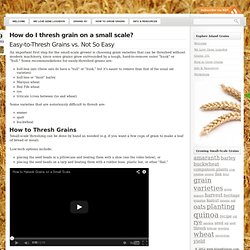
" Some recommendations for easily-threshed grains are: hull-less oats (these oats do have a "hull" or "husk," but it's easier to remove than that of the usual oat varieties)hull-less or "faust" barleyMarquis wheatRed Fife wheatryetriticale (cross between rye and wheat) Some varieties that are notoriously difficult to thresh are: emmerspeltbuckwheat. Eating Thorns- Foraging Milk Thistle. Alright, alright, I know what you're thinking.
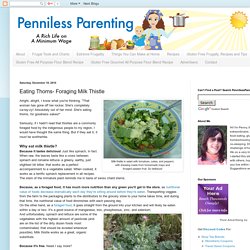
"That woman has gone off her rocker. Seed Balls: how to grow trees without really trying. While we started off experimenting with annual and ground cover species seed balls, to date I’ve been most impressed by how useful they’ve proved to help us establish trees in unlikely areas.
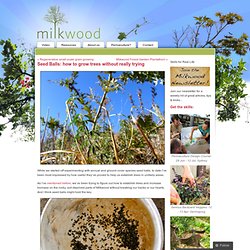
As I’ve mentioned before, we’ve been trying to figure out how to establish trees and increase biomass on the rocky, soil-deprived parts of Milkwood without breaking our backs or our hearts. And I think seed balls might hold the key. Scarified Black Wattle (Acacia mearnsii) seeds, ready to be seed balled Seed ball making: adding sieved red clay from the hill. Very small scale ..for home eating..grain planting and protein production. Loved those links..found this information very very helpful A bushel of wheat makes about fifty 1-pound loaves of bread.
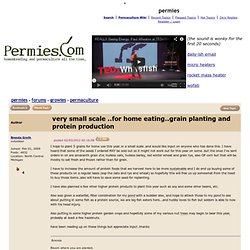
Two ears of corn make enough cornmeal for a meal's worth of corn muffins. The grain expands as it cooks with water, and so gives more food to eat than you would think the uncooked grain represented. At most, figure a year's supply of wheat at 4 pecks (1 bushel); corn, 2 pecks; popcorn, 2 pecks; soybeans, 4 pecks; grain sorghum, 2 pecks; buckwheat, 1 peck; oats, 1 peck; triticale or rye or barley, 1 peck; navy or other soup beans, 2 pecks; alfalfa for sprouting, 1 or 2 quarts; lentils, field peas, cane sorghum (for flour), about 2 quarts each.
Www.rivendellvillage.org/Natural-Way-Of-Farming-Masanobu-Fukuoka-Green-Philosophy.pdf. How to identify, clean, and store fresh grape leaves. One of the first, and favorite, things I ever wrote about food was a poem about picking grape leaves.

There is, it seems, poetry to be found in the memory of being a child following the ladies out to the edge of a parking lot somewhere to pick what felt like illicit leaves to be stuffed for our big pots of grape leaf rolls (also known as the Greek version, dolma or dolmades). Every spring, when the vines have unfurled their leaves at that perfect moment between tender and strong, I imagine the mass exodus of Lebanese coming out of their homes across the wide world and scurrying out to their secret vines to pick the leaves by the hundreds. It’s our pot of gold at the end of the rainbow, our holy grail, our heart’s content. In the Garden Online - Colleen's Picks - Ten Vegetables You Can Grow in Shade. It's a common misconception that the only site to grow vegetables in s one that's in full sun.
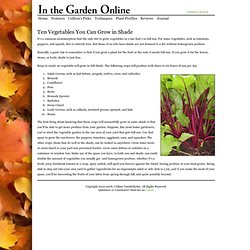
For some vegetables, such as tomatoes, peppers, and squash, this is entirely true. But those of us who have shade are not doomed to a life without homegrown produce. Basically, a good rule to remember is that if you grow a plant for the fruit or the root, it needs full sun. If you grow it for the leaves, stems, or buds, shade is just fine. Keep in mind, no vegetable will grow in full shade. Electroculture, Good vibes for Agriculture - Electroculture. Prospect Rock Permaculture. Fruit Tree Grafting Workshop and 2nd Annual Scionwood Exchange THIS IS LAST YEAR’s EVENT Willow Crossing Farm, Johnson, VT Hi Friends and Neighbors, Please feel free to share this event with potentially interested friends and networks, thanks!
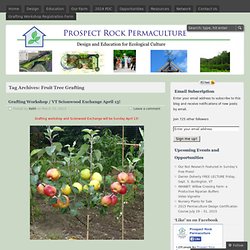
Thanks to everyone who came out for the pruning workshop- despite less than ideal weather it was a great success. Best Shade-Tolerant Vegetables - Organic Gardening. Even in shady conditions, you can bask in great garden harvests if you choose the right crops and make a few easy adjustments.
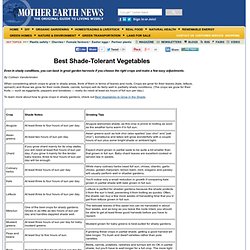
Herbal Treatment of Poison Oak using Grindelia. But if you are not fortunate enough to know when you contacted the plant - and bear in mind this oil can hang out on clothes, dog fur, tents, whatever, for weeks, until you touch it later - then you will probably end up with a skin reaction. The first thing you will probably notice is that your skin is itchy over the course of the next day or two. Then after another day or so, you will start getting small blisters that easily pop and weep fluid. This fluid itself is probably not going to spread any more poison oak, but if you have very sensitive skin and scratch it a lot, you might spread some remnants of oil from it for a weaker reaction elsewhere. Another danger of scratching is risking an infection in that area, especially if you are out in the woods.
There are several plants that are considered "remedies" for poison oak. Prescription steroids will help reduce your own reaction to this oil. Medicinal and Edible Plants. Wind & Sun Farm – A Permaculture Design (Part 2 of 4) - Midwest Permaculture. Part 2 of 2 Current Conditions The field is east facing with a substantial slope (approximately 20%) that is presently planted with alfalfa and a host of other prairie and pasture plants.
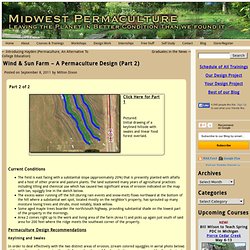
The land sustained many years of agricultural practices including tilling and chemical use which has caused two significant areas of erosion indicated on the map with tan, squiggly line in the sketch below.The excess water running off the hill (during rain events and snow-melt) flows northward at the bottom of the hill where a substantial wet spot, located mostly on the neighbor’s property, has sprouted up many moisture loving trees and shrubs, most notably, black willow.Some aged maple trees boarder the north/south highway, providing substantial shade on the lowest part of the property in the mornings.Area 2 comes right up to the work and living area of the farm (Area 1) and picks up again just south of said area for 200 feet where the ridge meets the southeast corner of the property.
Michigan crop harvest calendar - When fruit and vegetables are normally ready to pick in MI. This page has a table below that tells when each fruit or vegetable is normally ready to be harvested in Michigan! We also have a page with links to our own simple instructions on canning, freezing and drying many fruits and vegetables, such as how to make jam, apple butter, applesauce, spaghetti sauce, salsa, pickles, ketchup or freezing corn. Typical Crop Availability - When to Pick in Michigan The light green indicates light crops at the beginning, end, or in between seasons - dark green is when the bulk of the crop ripens and picking is best.
Typical apple ripening dates in Michigan. Temperate Climate Permaculture. Nature Is Our Greatest Teacher - Think and Be Inspired. 0 Email Share Nature Is Our Greatest Teacher We will use the farmer as our teacher. The farmer carefully prepares the ground, then sows his wheat and waits while the Law Of Increasing Returns brings back the seed he has sown, plus a many-fold increase. If this law of nature didn’t exist humanity would disappear, because if he could not make the soil produce enough food for his existence, then obviously he would die. There would be no advantage by sowing a field of wheat if the harvest did not return more than was sown. This ‘tip’ from nature is called the Law Of Increasing Returns. Nature never has any trickery connected to this law. The principles of a rocket stove and how to build one. A Farm for the Future 3.
One Straw Revolution Part 1. One Straw Revolution Part 2.mp4. Fukuoka style seed balls for no till farming. The Basics of Natural Farming (part 1 of 2) The Basics of Natural Farming (part 2 of 2) Biodynamic agriculture. Biodynamic agriculture is a method of organic farming originally developed by Rudolf Steiner that employs what proponents describe as "a holistic understanding of agricultural processes".[1]:145 One of the first sustainable agriculture movements,[2][3][4] it treats soil fertility, plant growth, and livestock care as ecologically interrelated tasks,[5][6][7] emphasizing spiritual and mystical perspectives.
Proponents of biodynamic agriculture, including Steiner, have characterized it as "spiritual science" as part of the larger anthroposophy movement.[1][2][8] Biodynamics has much in common with other organic approaches – it emphasizes the use of manures and composts and excludes the use of artificial chemicals on soil and plants. As of 2011 biodynamic techniques were used on 142,482 hectares in 47 countries. Germany accounts for 45% of the global total;[9] the remainder average 1750 ha per country. History[edit] How to make Compost Tea - Easy to make Organic Compost Tea for your Garden. So now for a compost tea recipe that I currently used and have success with Equipment needed - A Bucket ( size depending on how much compost tea you plan to make) - Aeration Device ( simple aquarium air pump will work fine , used to force air into the mixture) Ingredients. Anltrend.gif (682×870)
Wine Grower News #141 - September 3, 2010. American Indian Soups and Stews. What to compost. Click on a letter to find the organic material you are looking for. Nitrogen. Compost in worm bin. See Food Wastes. How to Eat Maple Seeds. MAPLE LEAVES AND OTHER EDIBLE PLANTS. Raw Squash On A Healthy Diet. Raw squash is surprisingly versatile, and a good addition to a number of healthy recipes. We tend to think of these foods as only having a place in cooked cuisine, but many are edible and tasty raw. The key is picking the right ones. Permaculture for renters. Phylloxera - they thrive because of the parking lot style growing. Grape phylloxera (Daktulosphaira vitifoliae (Fitch 1855); family Phylloxeridae); originally described in France as Phylloxera vastatrix; equated to the previously described Daktulosphaira vitifoliae, Phylloxera vitifoliae; commonly just called phylloxera (/fɪˈlɒksərə/; from Greek φύλλον, leaf, and ξερόν, dry) is a pest of commercial grapevines worldwide, originally native to eastern North America.
Plants aren't meant to grow like this. Adventures in Urban Sustainability - Happy Earth. Goodness, this June marks five years since we embarked on our adventure in urban sustainability and set about transforming a typical house and lawn into a healthy, eco friendly home with a flourishing food garden. Allard Research & Development. Frequently Asked Questions. Small Farms Library - Journey to Forever. Weeds, Guardians of the Soil. Sepp Holzer - Permaculture - Farming with Terraces and Raised Beds (Part 1 of 4)
Permaculture Seed Balls "The Fukuoka Method" Masanobu Fukuoka's Natural Farming and Permaculture. Masanobu Fukuoka is a farmer/philosopher who lives on the Island of Shikoku, in southern Japan. Fukuoka in Greece (2/3) A Rosetta Stone of "Self-watering" Permaculture and cultivation techniques. Robert Hart (horticulturist) Robert Hart pictured in his forest garden, July 1997. Frank Cook: "Why Don't We Harvest Instead of Weed?" Companion Planting Information and Chart. Forest gardening. Liquid Gold. Human Urine - Soil Forum. Masanobu fukuoka « Experiential Malleabis. Extraordinary Off-Grid Hobbit Home in Wales Only Cost £3,000 to Build Simondale Hobbit House - Gallery Page 9. Agriculture Library Index.
Siskiyou Permaculture Resources Group - Interview with Fukuoka. Rocketstoves - www.ErnieAndErica.info. November 2009. Earthrise - The Great Seed Bank. Top 100: Prostrate Herbs (Miner's Lettuce) Wild Medicine. Coming Soon: A Forest You Can Eat. Barnyard Grass. A Kitchen Garden in Kihei Maui. April 2012. The Root Development of Vegetable Crops: Astonishing Illustrations. Acorns - Perennial Food. Edible Wild Food » Foraging for Evening Primrose.
Wild pesto. Evening Primrose Oil Benefits & Information (Oenothera Biennis) Ohio Perennial and Biennial Weed Guide. Removing water from sap. Kauri tree. Making Our Sustainable Life. Interview With Mark Shepard of New Forest Farm - EthicalFoods.com. Martin Crawford - Van-Kal Permaculture. Feedipedia - Animal Feed Resources Information System. Farming in Nature's Image: An Ecological Approach To Agriculture - Judy Soule. Plants and Flowers that will Grow and Thrive in Full Shade. Launch of website on crop wild relatives and climate change. Wild tomatoes for climate change. Stalking the wild broccoli (and giveaway winner) Potential survival of potato volunteers in Michigan in 2014. Vegetables « Four String Farm. Experiences electroculture - The cosmo-telluric Agriculture. Clouds, Cloudiness, Surface Temperature, the Greenhouse Effect and Global Climate Change.
Cherry Seeds - Growing from Seed Forum. Tour of Permaculture Farm In Auroville - Part 1. Wild Grape Vine: Pictures, Flowers, Leaves and Identification. Puyallup.wsu.edu/~linda chalker-scott/Horticultural Myths_files/Myths/Compost tea again.pdf. Rediscover Anaerobic Composting - An Ancient Fertilizer.